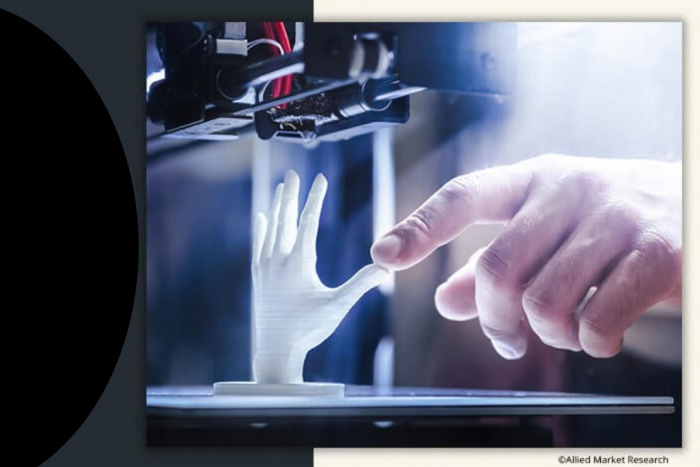3D printing construction market
3D printing is a manufacturing process that creates physical objects based on digital designs. This is achieved with the help of an additive process, where an object is created by a machine that prints various layers of material until the object is completed.
3D printing in construction is also referred to as 'building printing' or 'contour crafting'.
3D printing in the construction industry may help tackle the housing crisis as it can allow 3D printing offers lower labour costs and construction can be completed more quickly. In addition, 3D printing produces little waste and the various wasted raw materials from printing that include failed prints and concrete waste can be recycled. It also helps simplify construction models and plans - the reason being the shapes and structures desired by designers can be printed with high precision.new structures to be created quickly.
Key players operating in the global 3D printing in construction market includes Zhuoda Group, WASP, Urban3D Company, Cazza Construction Company, Apis Cor, WinSun, Belatchew Arkitekter, DUS Architects, Skanska, Fosters+Partners, Lafarge, Carilliom Plc., Balfour Beatty and Sika, among others.
In September 2018, Italy-based WASP unveiled “the infinity 3D printer”, a construction system that is mainly used to print sustainable houses. It is designed to fast-track the development of the technological village of Shamballa. This is basically a WASP project that aims to develop various 3D-printed, environment-friendly houses. WASP also developed the world’s largest 3D printers that can build homes from locally-sourced materials by using wind, solar or hydro power. This in turn enables regions that do not have access to electricity to 3D print eco-friendly structures sourced through local resources.
Urban3D Company was founded to respond to the housing crisis in Brazil. The company is currently (2019) testing various prototypes and aims to provide various solutions to the development of Brazilian shantytowns.
Apis Cor, based in Russia, is also adopting 3D-printing technology and is the first company to develop specialised equipment for 3D printing in construction .This equipment aims to print whole buildings on site.
Companies are also focusing on special robots that are used for 3D printing. For example, Cazza, based in the US, built the Cazza X1, concrete house 3D printer that was mainly designed for disaster prone areas. These structures can withstand severe tornados, earthquakes, and others, so that people in vulnerable areas can be provided with immediate housing facilities.
3D-printed technology is also used to explore space. NASA's 3D-Printed Habitat Challenge aims to examine various technologies to build homes in space, such as on Mars or on the Moon.
3D-printing techniques also find applications in aerospace, defense, automobile, health, and mechanical applications among others, with printing materials specified as required. Advanced materials combined with cutting-edging printing technology and various advanced computer algorithms have made 3D technology very affordable; this in turn is expected to drive the demand for this market.
3D Printing in construction is mainly driven by the need for sustainable, new, smart housing and eco-friendly solutions. The affordability and speed of buildings are other factors driving the Asia-Pacific market. Rising demand for commercial buildings is also expected to drive the market. Asia-Pacific accounts for the largest revenue share in the global market. Growth in the Asia-Pacific region is mainly attributed to the increasing usage of 3D-printing in China. Rapid industrialisation, high population and urbanisation followed by a growth in concern for environmental pollution and human health is expected to boost the market demand for 3D printing in the Asia-Pacific construction sector.
[edit] Related articles on Designing Buildings Wiki
- 3D concrete printer.
- 3D concrete printing market.
- 3D printed bridge.
- 3D Printed Office Dubai.
- 3D printing.
- 3D printing Michelangelo's David in concrete.
- Advanced construction technology.
- Advanced manufacturing.
- At a glance - 3D printing.
- Building information modelling.
- Computer aided manufacturing.
- Offsite manufacturing.
- Printing 3D models of buildings.
- WikiHouse.
Featured articles and news
RTPI leader to become new CIOB Chief Executive Officer
Dr Victoria Hills MRTPI, FICE to take over after Caroline Gumble’s departure.
Social and affordable housing, a long term plan for delivery
The “Delivering a Decade of Renewal for Social and Affordable Housing” strategy sets out future path.
A change to adoptive architecture
Effects of global weather warming on architectural detailing, material choice and human interaction.
The proposed publicly owned and backed subsidiary of Homes England, to facilitate new homes.
How big is the problem and what can we do to mitigate the effects?
Overheating guidance and tools for building designers
A number of cool guides to help with the heat.
The UK's Modern Industrial Strategy: A 10 year plan
Previous consultation criticism, current key elements and general support with some persisting reservations.
Building Safety Regulator reforms
New roles, new staff and a new fast track service pave the way for a single construction regulator.
Architectural Technologist CPDs and Communications
CIAT CPD… and how you can do it!
Cooling centres and cool spaces
Managing extreme heat in cities by directing the public to places for heat stress relief and water sources.
Winter gardens: A brief history and warm variations
Extending the season with glass in different forms and terms.
Restoring Great Yarmouth's Winter Gardens
Transforming one of the least sustainable constructions imaginable.
Construction Skills Mission Board launch sector drive
Newly formed government and industry collaboration set strategy for recruiting an additional 100,000 construction workers a year.
New Architects Code comes into effect in September 2025
ARB Architects Code of Conduct and Practice available with ongoing consultation regarding guidance.
Welsh Skills Body (Medr) launches ambitious plan
The new skills body brings together funding and regulation of tertiary education and research for the devolved nation.
Paul Gandy FCIOB announced as next CIOB President
Former Tilbury Douglas CEO takes helm.
UK Infrastructure: A 10 Year Strategy. In brief with reactions
With the National Infrastructure and Service Transformation Authority (NISTA).
























Comments